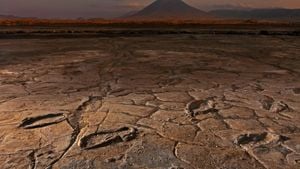This Thanksgiving weekend, millions of Americans could experience the breathtaking display of the Northern Lights, also known as the aurora borealis, lighting up the night sky. The National Oceanic and Atmospheric Administration (NOAA) has issued geomagnetic storm watches, forecasting potential auroras visible from several northern U.S. states, including New York, Idaho, and Washington.
The chances of witnessing this celestial phenomenon are heightened by the current solar activity, as the solar maximum of Solar Cycle 25 is underway. Solar maximum occurs approximately every eleven years and is characterized by increased solar flares and coronal mass ejections (CMEs), both of which contribute to geomagnetic storms on Earth. The recent storm, resulting from a CME associated with sunspot region 3901, is expected to be at its peak on Thanksgiving night.
On Thursday, November 28, the NOAA predicts G1 (minor) geomagnetic storm conditions could strike Earth between 1:00 and 4:00 PM EST, intensifying to G2 (moderate) by the evening hours, leading to optimal viewing times between 10 PM and 2 AM local time. These predictions have sparked enthusiasm among skywatchers as the auroras might extend farther south than usual this year, thanks to the increased activity on the sun.
Traditionally, northern lights are seen near the magnetic poles, but this year's solar dynamics mean states across the northern tier of the U.S., including Montana, Michigan, North Dakota, and potentially even areas like New York or Pennsylvania, might also catch the elusive glow. Understanding the Kp index, which measures geomagnetic activity on a scale from 0 to 9, can be beneficial when gauging visibility. A Kp index of 5 suggests moderately strong activity, which means the auroras, if they appear, may be vivid and widespread.
For those hoping to catch the show, clear skies are imperative. Experts advise stepping away from city lights to find darker areas where the auroras can be most visible. NOAA emphasizes the importance of checking their aurora dashboard for real-time updates and local forecasts to stay tuned to changing visibility conditions.Select areas may experience cloudiness or precipitation, which could obstruct the view, so planning to escape cloudy weather could maximize the experience.
Shawn Dahl, coordinator for NOAA's Space Weather Prediction Center, highlights the significance of experiencing the Northern Lights during this solar maximum phase. “We’re on this roller coaster ride of solar activity for the rest of this year and all of next year,” he noted, offering hope to aurora enthusiasts about more opportunities to view this marvelous light show. Indeed, the current solar maximum will mean more frequent and intense geomagnetic storms, offering even more chances for viewing the Northern Lights over the coming months.
While the primary draw for many is the stunning sight of the Northern Lights, there are side effects to the geomagnetic activity driven by the sun. Strong storms can disrupt communications systems, including GPS and radio transmissions, as well as cause voltage issues for power grids. Thankfully, NOAA projects this week’s storms will not lead to major disruptions.
Those within the paths predicted for aurora visibility are encouraged to take advantage of this natural light display. Providing tips on photography, experts suggest utilizing long-exposure settings on cameras or smartphones, as the faint hues of the aurora may not be fully visible to the naked eye yet catch beautifully on camera. The best viewing conditions may highlight green and pink waves dancing across the night sky, creating one of nature's most phenomenal spectacles.
Regions around the Great Lakes and parts of the Midwest, along with northern states like Minnesota and Wisconsin, could also witness these vivid auroras under the right circumstances. Visibility, of course, will also depend heavily on local weather conditions; some areas might experience overcast skies which could shroud the auroras from clear eyesight, resulting in limited visibility chances. Therefore, staying informed on predicted weather patterns is key.
This year’s Thanksgiving is shaping up to be quite magical, as families gather and share meals, the opportunity to step outside and behold such extraordinary natural beauty right above them is added frosting to the holiday cake. After the festivities have fizzled and night falls, many may find themselves gazing upward, hoping to catch even just a glimpse of the Northern Lights painting the night sky toward their homes.
According to forecasts, the potential for auroras will continue to last beyond the Thanksgiving holiday. This upcoming solar activity, heightened by the peak of the solar maximum phase, signals more auroras on the horizon for skywatchers and novices alike, continuing to open doors for awe-inspiring experiences as nature puts on one of its most colorful shows.



